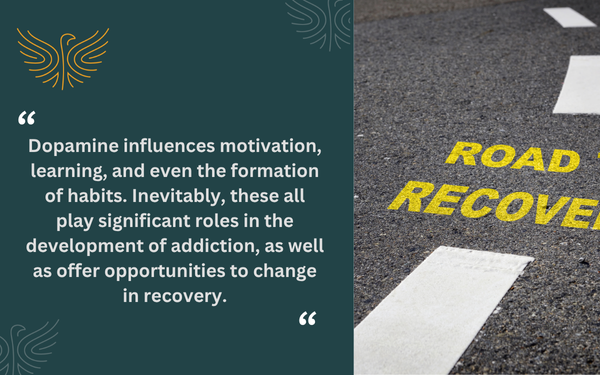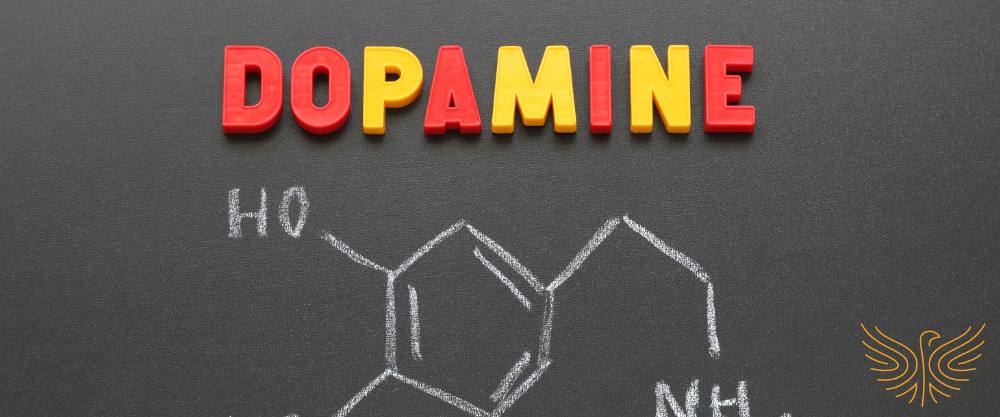You’ve likely read about trendy “dopamine detoxes” and how quick hits of dopamine drive addiction, as well as plenty of other unhealthy habits. But this tends to oversimplify dopamine and its role in both addiction and recovery.
In fact, dopamine influences motivation, learning, and even the formation of habits1. Inevitably, these all play significant roles in the development of addiction, as well as offer opportunities to change in recovery. So, how does dopamine impact the brain? What exactly is its role in addiction and recovery? Keep reading to learn more.

_______________________________________________________
How the Brain’s Reward Pathway Works
The dopamine reward pathway starts in a tiny hub called the VTA2, passes through the nucleus accumbens, and finishes in the prefrontal cortex3, which helps you plan and decide. When you do something healthy—eat a good meal, hug a friend, or hit a goal—this loop sends out a quick burst of dopamine (about 50‑100 % above normal). And this signals to your brain that more of this is a good thing!
However, addictive drugs and compulsive behaviors use the same pathway, but they crank dopamine up 200‑1,000%. Over time, these massive spikes push everything else down the priority list, training the brain to chase that high no matter the cost4.
Addiction Hijacks the Brain’s Reward System
When substances or addictive behaviors flood the synapse with dopamine, they create an exaggerated learning signal far beyond anything natural rewards produce. This massive dopamine spike tells the brain that this experience is extraordinarily valuable—more important than food, relationships, or other survival needs. The brain responds by encoding the substance or behavior as a high-priority survival cue.
And this is why addiction feels so compelling. The brain literally rewrites its motivational hierarchy, placing the addictive substance at the top. Then, each use strengthens these neural pathways, making the behavior increasingly automatic and difficult to resist. The dopamine system, designed to help us survive, thus becomes the very mechanism that threatens our well-being.
Tolerance Also Plays a Role Here
Chronic overstimulation triggers the brain’s protective response5. And this is where the dopamine receptor can become downregulated. Like turning down a speaker that's too loud, the brain reduces receptor density to manage the overwhelming input. This adaptation means users need increasingly larger amounts to achieve the same effect—the hallmark of tolerance.
More troubling, this receptor pruning creates a state of diminished baseline pleasure. Normal activities that once brought joy—a good meal, time with friends, accomplishments at work—no longer trigger sufficient dopamine release to feel rewarding.
Dopamine Can Create Hurdles in Recovery
Even after achieving abstinence, the dopamine system’s learned associations remain stubbornly intact. Environmental cues—the sight of a bar or the sound of ice clinking in a glass—can reactivate dormant dopaminergic firing patterns. These cue-triggered responses can quickly lead to relapse, no matter how committed you might be to your recovery.
On top of this, chronic dopamine dysregulation6 severely compromises the prefrontal cortex’s executive functions. This brain region, responsible for impulse control, decision-making, and future planning, relies on balanced dopamine signaling to function properly. In the throes of addiction, the prefrontal cortex becomes both overactive (driving drug-seeking) and underactive (failing to inhibit impulses).
This executive dysfunction manifests as poor judgment, inability to consider consequences, and difficulty resisting immediate gratification. And this can continue after drug use, during recovery as your brain recalibrates. Inevitably, healing takes time.
It Can Lead to Co-Occurring Mental Health Issues
Chronic dopamine dysregulation rarely occurs in isolation. The same neurotransmitter imbalances driving addiction frequently intersect with anxiety, depression, ADHD, and other mental health conditions. This creates a vicious feedback loop; mental health symptoms drive self-medication attempts, which further destabilize dopamine systems, worsening both conditions.
Many people with addiction discover they’ve been unconsciously attempting to normalize pre-existing dopamine irregularities. ADHD brains, for instance, often have lower baseline dopamine, making stimulant drugs temporarily corrective before tolerance develops. Luckily, in many rehab programs, including those at Freedom Recovery Centers (FRC), professionals treat co-existing conditions and understand that addiction often isn’t an isolated diagnosis.
_______________________________________________________
How to Re-Balance Dopamine
Resetting the brain’s reward system happens when medical, psychological, and lifestyle strategies work together—each one reinforcing the others.
- Pharmacotherapy: Medications such as bupropion (which mildly boosts dopamine to ease low mood and cravings) and naltrexone (which blunts the dopamine “rush” from alcohol or opioids) can steady dopamine tone during recovery. Because responses differ from person to person, these drugs should be prescribed and monitored by a clinician as part of a broader treatment plan.
- Behavioral therapies & neuroplasticity: Cognitive Behavioral Therapy (CBT), Dialectical Behavior Therapy (DBT), and mindfulness training help you find reward in healthier activities—such as exercise, social connection, and achieving recovery milestones.
- Lifestyle interventions: Daily habits make a big difference. For instance, quality sleep allows your dopamine receptors to reset, nutrient-dense foods rich in tyrosine provide the raw material for dopamine production, and sunlight, aerobic exercise, and meditation offer gentle, healthy boosts. However, it’s always important to start small; adding these changes gradually prevents overwhelm and supports long‑term balance.
_______________________________________________________
Recovery is Possible
Addiction rewires the brain’s dopamine system, but recovery can rewire it back. Thanks to neuroplasticity—the brain’s lifelong ability to form new neural pathways—the damage isn’t permanent.
With the right combination of medical support, therapy, lifestyle changes, and time, the reward system can heal. Hope lies not in quick fixes but in understanding that lasting recovery means patiently rebuilding the brain’s natural capacity for joy, motivation, and satisfaction.
At Freedom Recovery Centers (FRC), our caring and expert team is ready to help guide you toward lasting healing. For more information, call us at 804-635-3746 or fill out our online form.
.svg)






.svg)

.svg)



.svg)
